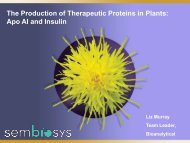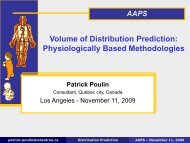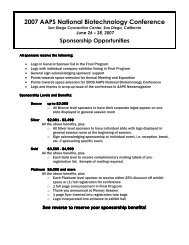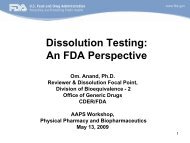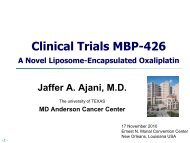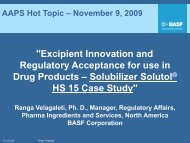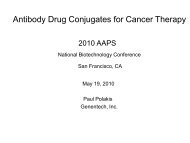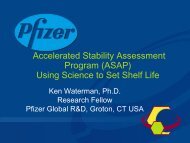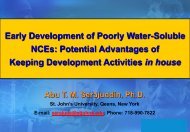Preliminary Program - American Association of Pharmaceutical ...
Preliminary Program - American Association of Pharmaceutical ...
Preliminary Program - American Association of Pharmaceutical ...
Create successful ePaper yourself
Turn your PDF publications into a flip-book with our unique Google optimized e-Paper software.
61<br />
2009 AAPS Annual Meeting and Exposition<br />
Physical Pharmacy and Biopharmaceutics (PPB) <strong>Program</strong>ming<br />
Successful Methods for Systemic Exposure<br />
Optimization: IVIVC and Proven Formulation<br />
Strategies to Predict Clinical and Preclinical<br />
Outcome for Drugs <strong>of</strong> All BCS Classes<br />
Handan He, Ph.D.<br />
Novartis<br />
Systemic Exposure and Oral Absorption<br />
Assessment <strong>of</strong> Poorly Water-soluble Drugs in<br />
the Fasted and Fed State to Predict Clinical<br />
Outcome<br />
Makoto Kataoka, Ph.D.<br />
Setsunan University<br />
BDDCS vs. BCS as an Enabling Tool in Drugs<br />
Discovery: Evolving Understandings <strong>of</strong><br />
Disposition for BCS Class II-IV Drugs<br />
Leslie Benet, Ph.D.<br />
University <strong>of</strong> California San Francisco<br />
JOINT MEMBERSHIP MEETING AND<br />
RECEPTION<br />
5:30 pm – 7:30 pm<br />
Physical Pharmacy and<br />
Biopharmaceutics (PPB) Section Joint<br />
Membership Meeting and Reception<br />
Tuesday, November 10, 2009<br />
TUESDAY SUNRISE SESSIONS<br />
7:00 am – 8:15 am<br />
Solve Your Problems in a Smarter Way:<br />
Use Design <strong>of</strong> Experiments<br />
Sunrise Session<br />
Too many variables to control in your experiments?<br />
What is the optimal set <strong>of</strong> conditions that will lead<br />
you to the desired results? The traditional approach<br />
to answer the above questions is to do experiments<br />
and evaluate the contribution <strong>of</strong> the different<br />
factors (variables), one factor at a time, while the<br />
other factors are held constant. One problem in this<br />
approach arises when there are too many factors to<br />
test. You can bypass this frustration and reach your<br />
goal by designing experiments in an intelligent way,<br />
using Design <strong>of</strong> Experiments. Design <strong>of</strong> Experiments<br />
(DOE) is a strategy to gather data from experiments<br />
in order to optimize a process, understand a<br />
phenomenon,or improve a performance. DOE<br />
consists <strong>of</strong> designing a set <strong>of</strong> ten to twenty<br />
experiments in which all relevant factors are varied<br />
in a systematic way. The analysis <strong>of</strong> the results <strong>of</strong><br />
these experiments will help us discover the factors<br />
that most influence the results and the factors that<br />
do not, and spot patterns <strong>of</strong> interactions between<br />
factors. In other words, DOE helps to identify the<br />
optimal conditions <strong>of</strong> a process based on a few key<br />
experiments. DOE’s beauty is that it allows you to<br />
find the best answer much more quickly and has<br />
broad applications across all natural sciences. In<br />
this session, we will give the basics <strong>of</strong> DOE, discuss<br />
real-life case scenarios and learn how to organize<br />
experiments in order to get the right type and<br />
number <strong>of</strong> data to answer our questions.<br />
Moderator<br />
Maria Polikandritou-Lambros, Ph.D.<br />
Western University <strong>of</strong> Health<br />
The Basics <strong>of</strong> Experimental Design<br />
Mike Nicolaou, Ph.D.<br />
Nicopharm <strong>Pharmaceutical</strong> Solutions<br />
TUESDAY MORNING SYMPOSIA<br />
8:30 am – 11:00 am<br />
Application <strong>of</strong> Nanoparticulate<br />
Technology in the Development <strong>of</strong> Oral<br />
Dosage Forms: Impact on Drug Product<br />
Performance<br />
Symposium<br />
Session description not available at time<br />
<strong>of</strong> publication.<br />
Moderators<br />
S. Russ Lehrman, Ph.D.<br />
Lehrman Biopharma<br />
Vijai Kumar, Ph.D.<br />
<strong>Pharmaceutical</strong>s International, Inc.<br />
<strong>Pharmaceutical</strong> Nanoparticles: Current Design<br />
Concepts and Challenges<br />
Mansoor Khan, Ph.D., M.S., R.Ph.<br />
U.S. Food and Drug Administration<br />
Oral Delivery <strong>of</strong> Poorly Water-soluble Drugs<br />
by In Situ Nanoparticle Formation Applying<br />
Microemulsion and Solid Dispersion<br />
Technologies<br />
Abu T.M. Serajuddin, Ph.D.<br />
St. John’s University<br />
Application <strong>of</strong> Nanocrystal Technology to<br />
Poorly Water Soluble Compounds<br />
Gary Liversidge, Ph.D.<br />
Elan Drug Delivery Inc.<br />
Engineering <strong>Pharmaceutical</strong> Nanoparticles<br />
Cory J. Berkland, Ph.D.<br />
University <strong>of</strong> Kansas<br />
AAPS Graduate Student Symposia<br />
and Research Achievement Awards<br />
8:30 am – 11:00 am<br />
AAPS Graduate Student Symposium<br />
in Physical Pharmacy and<br />
Biopharmaceutics (PPB)<br />
Sponsored by<br />
During this Symposium, a presentation from the Research<br />
Achievement Award winner will be given.<br />
AAPS David Grant Research Achievement Award in<br />
Physical Pharmacy<br />
Sponsored by<br />
TUESDAY AFTERNOON ROUNDTABLES<br />
Funded by a Grant from<br />
2:00 pm – 4:00 pm<br />
Characterization <strong>of</strong> Amorphous<br />
<strong>Pharmaceutical</strong> Solids and Solid<br />
Dispersions<br />
Roundtable<br />
Discussions on recent exploration <strong>of</strong> amorphous<br />
pharmaceutical solids and related solid dispersion<br />
technology at national and international forums<br />
have been limited. Numerous challenges exist<br />
in consistently and reproducibly generating high<br />
energy solid materials, characterizing high energy<br />
solids regarding its in vitro performance, selecting<br />
and optimizing the appropriate polymeric matrices<br />
for achieving physical stability, selecting desired<br />
manufacturing process with optimal conditions,<br />
achieving improved in vivo exposure, and<br />
developing formulation products intended for oral<br />
use. It is proposed that this roundtable will focus<br />
on key aspects <strong>of</strong> amorphous solids and related<br />
drug product development, including generating<br />
amorphous materials via different manufacturing<br />
processes, selecting polymer to stabilize the<br />
amorphous state, making appropriate formulations<br />
intended for oral administration, characterizing and<br />
understanding solid state physical stability, applying<br />
appropriate analytical methodologies, etc. This will<br />
pr<strong>of</strong>oundly influence the scientific community <strong>of</strong>




